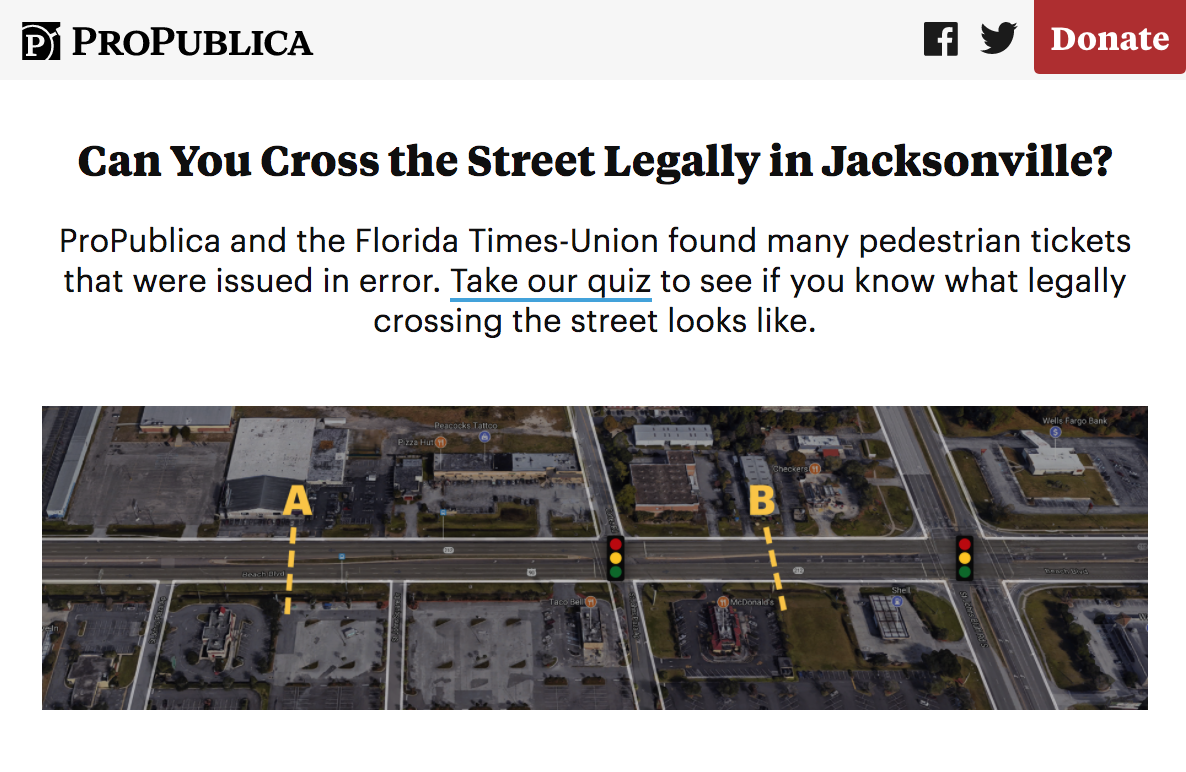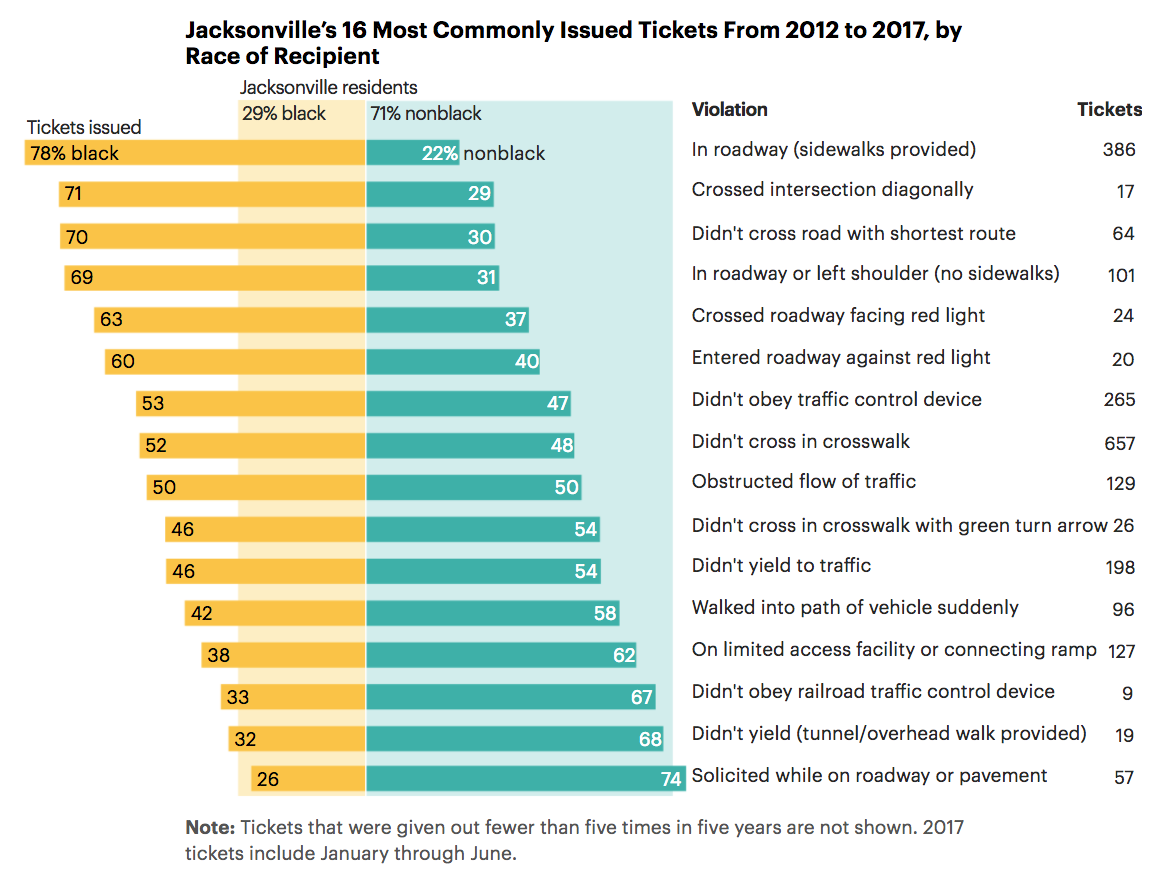How ProPublica exposed racial profiling in pedestrian citations in Florida
Are black people more apt to get ticketed by police for pedestrian violations in Jacksonville, Florida? Yes, a recent ProPublica investigation found, three times as likely as whites. Using months of reporting, a short-form video, data visualization, and interactive quizzes, ProPublica told the story of the racial discrepancies that exist in Jacksonville’s attempt to prevent pedestrian deaths. The piece was co-published with the Florida Times-Union.
Storybench spoke with Topher Sanders, a racial inequality reporter at ProPublica, about how he and his colleagues collaborated to create his piece “Walking While Black.”
How did you come up with the idea for the story?
I came up with the story with my friend and colleague Ben Conarck, whose name you see on the story. Ben wrote a story in Jacksonville about this guy who got stopped by a cop for jaywalking. And he wrote about the guy’s encounter; he wrote it up, and it’s pretty straightforward. The guy got stopped, he was given these tickets, he looked up these tickets. He wrote the story up, ‘cause he looked up one of the tickets that he was given, it turned out to be an inappropriate ticket and it was intended only for a motorist but he had given it to a dude on foot. And in the video, I’m sitting in my office and I watch the cop go, “So do you have your ID?” and the guy goes, “Nah, I don’t have my ID,” and the cop goes, “See! See, there’s another violation.” And I’m watching this dude, and I’m like, man, that sounds an awful lot like black code laws, where you can’t walk around the neighborhood unless you’ve got some papers. I call up Ben, say, “Hey Ben, man, I bet they do this a lot. Want to see if we can find out how?” And Ben is like, “Yeah, let’s go.”
How did the accompanying video get pitched?
There’s a fellowship program between Vox and ProPublica. So the person that put our video together, Ranjani [Chakraborty], she’s a part of the fellowship. She came into the meeting and listened to the findings that we had. By this point now, from the time I pitched the editor on this, we’re maybe a month and a half down the road now, so we’ve gotten a better handle on data, a better handle on what’s actually happening. So we have this meeting and I explain to them some of our findings. They think that there’s a lot of potential there, and Ranjani, the person that put together the video, said, “Hey, let’s do it. Let me talk to Vox,” and Vox said, “Yeah, let’s do it,” and about two weeks later we were in Jacksonville shooting.
How did you contribute to the video’s production?
[I contributed] all the findings and the script. As far as an ultimate vision for it, Ranjani had access to all of our notebooks material: interviews, rough sketches on data, rough sketches on pursuits of data. She sends the script to me and Ben, and we bulletproof it for accuracy. And then [we] make it something that we can say as reporters, and not something that’s too hyperbolic or anything. All the data and findings associated with the stuff you see in there, like any numbers, or anything related to conversations with the sheriff’s office, that was all us. Also, the idea of us doing the stakeout on the cops and watching them jaywalk came from me and Ben.
How did you collaborate with the data team to produce the graphics?
That’s a deep collaboration almost from the beginning. There were always assistants on data from the beginning, but towards the latter half of the reporting, the data team got heavily involved and began to do some deep vetting of the data that I crunched. They also assisted with doing some correlation analysis, things that I didn’t have the bandwidth to do. As far as how we worked with them: once they’re involved, it’s hand-in-hand, it’s step-by-step, they know what we’re doing, they have an idea, they have visibility on all data.
How much input did you have with what data you decided to present visually versus in writing?
We had several meetings about ideas around graphics. They kick around their really smart ideas around graphics. Me and Ben really just serve as making sure, “If we did this, is that accurate?” But they’re kicking around all of the creative ideas when it comes to what a graphic looks like and what we may have in it.
Did they also come up with ideas to add the interactive graphic explorations?
I came up with that idea after being given a quiz by a local lawmaker in Jacksonville. The lawmaker presents us a quiz, I say, “Hey, I think this is awesome.” I bring it back to ProPublica and say, “I think we should use this,” and ProPublica sees it and says, “you’re right,” and they made us a small version of the quiz, interactive.
What advice do you have for future journalists, especially in the area of incorporating other digital media into their pieces?
This is going to sound real lame, and real uninspiring, and not very sexy, but go find good stories. The whole platform thing – digital, print – all that will work itself out. But it doesn’t matter if your story’s not good. If you find good stories, they’ll find a home, whether its digital, or print, or both, which is pretty much the case now.
And try to find people who like what they’re doing, and who seem to be engaged in the story you discovered, to help you put it together for any kind of digital presentation. If you find good folks who are interested in your subject matter, they’re going to do good work on it. I don’t think there’s a real science around it, a good story is a good story is a good story. Reporters typically don’t have the skills to do the digital wizardry stuff, but you just have to find the right people to help you with that. But if you find a good story, all that other stuff will take care of itself.
- How ProPublica exposed racial profiling in pedestrian citations in Florida - February 7, 2018






